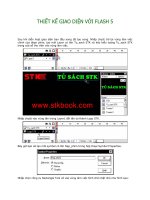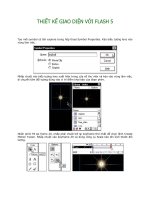CTT 534 Thiết kế giao diện LN10 tools
Bạn đang xem bản rút gọn của tài liệu. Xem và tải ngay bản đầy đủ của tài liệu tại đây (1.17 MB, 41 trang )
CTT534 – Thiết Kế Giao Diện
HK II 2013 – 2014
UI Architectures
and Development Tools
Some slides adapted from materials of MIT
CS Course 6.813/6.831
Outline
4/27/2014
Architectures and design patterns for UIs
UI development tools
2
Read-evaluation architecture
repeat
read-event(myevent)
case myevent.type
type_1:
do type_1 processing
type_2:
do type_2 processing
...
type_n:
do type_n processing
end case
end repeat
Flowchart
Pseudo-code
• The application has complete control over the event processing
• Programmer must execute this control over every event that the client will
receive
very cumbersome task
4/27/2014
3
Separating UI from application
One aim of a UI architecture is to separate the
interface from the application
Provides
4/27/2014
Portability
Reuse
Multiple Interfaces
Customization
Maintainability
Cost savings
4
Notification-based architecture
Example
4/27/2014
A simple interface for a “Save” and “Quit” operation
5
Notification-based architecture (cont’d)
void main(String[] args) {
Menu menu = new Menu();
menu.setOption(“Save”);
menu.setOption(“Quit”);
menu.setAction(“Save”,mySave)
menu.setAction(“Quit”,myQuit)
...
}
int mySave(Event e) {
// save the current file
}
int myQuit(Event e) {
// close down
}
4/27/2014
6
Notification-based architecture (cont’d)
Main control loop for the event processing is outside
the application
A centralized notifier
receives events from the windows system
filters events to the application program
The control flow is not controlled by application
programmer
4/27/2014
7
Model-View-Controller (MVC)
4/27/2014
8
MVC example: textbox
4/27/2014
9
MVC: advantages
Separation of concerns
Model: data
View: output
Controller: input
Supporting
Reuse
Portability
Multiple interfaces
Maintainability
4/27/2014
Reuse of models and views
Changes in view can be done with minimal effects on model
10
Hard to separate View and Controller
Controller often needs output
View must provide affordances for controller
View must provide feedback about controller state
e.g., button border and/or icon
e.g., depressed button
State shared between controller and view
Must be displayed by the view
Must be updated and used by the controller
Example
4/27/2014
Checkbox: who manages it when it’s checked and
unchecked?
11
Widget: tightly coupled view and controller
The MVC idea has largely been replaced by the MV
idea
A widget is a reusable view object that manages
both its input and output
Also called
Example
4/27/2014
Components in Java or Flex
Controls in Windows
Menubar
Button
Editbox
12
Presentation-Abstraction-Control (PAC)
A hierarchical structure of agents, each consisting of
a triad of Presentation (View), Abstraction (Model),
and Control
Somewhat similar to MVC, but…
Completely insulates the Presentation (View in MVC) and
the Abstraction
4/27/2014
provides the option to separately multithread the model and
view
the user interface (presentation) can be shown before the
abstraction has fully initialized
13
Presentation-Abstraction-Control (PAC)
A
P
C
Abstraction
A
P
C
Presentation
Control
A
P
C
A
P
C
4/27/2014
14
Outline
4/27/2014
Architectures and design patterns for UIs
UI development tools
15
Layers of UI development tools
Layers of development tools can be broadly
categorized into
4/27/2014
Windowing systems
Interface Development Toolkits (IDT)
User Interface Management Systems (UIMS)
16
Windowing systems
Elements
Device independence
Abstract terminal device drivers
Image models for output and (partially) input
Multiple application control
4/27/2014
pixels
PostScript (MacOS X, NextStep)
Graphical Kernel System (GKS)
Simultaneous user tasks
Supports independent processes
Isolation of individual applications
17
Architectures of windowing system
4/27/2014
18
The Client-Server architecture
4/27/2014
19
X Windows architecture
4/27/2014
20
UI development in windowing systems
UI development tools use window managers as
the foundation upon which a user interface can
be built
A window manager allows the user to display, alter,
and interact with more than one window at a time
The window manager's primary responsibility is to
keep track of all aspects of each of the windows being
displayed
4/27/2014
21
Example: Android
Google mobile platform
A software stack for
mobile devices
Core applications
email, browser, maps, SMS
Application Framework
OS, middleware, tools,
apps
Apps and GUI builder
Linux kernel
Java programming language
4/27/2014
22
Interface Development Toolkits (IDT)
IDT
Provides an interactive editor to layout the interface
May provide limited dialogue definition
Produces code that represents layout and dialogue (if any)
Object interaction example
4/27/2014
Input and output are linked
23
Interface Development Toolkits (IDT)
Advantages
4/27/2014
Programming with interaction objects (or techniques,
widgets, gadgets)
Promote consistency and generalizability
Support similar look and feel
Similar to object-oriented programming
24
Interface Development Toolkits (IDT)
Motif for X-window system
4/27/2014
MFC
25









